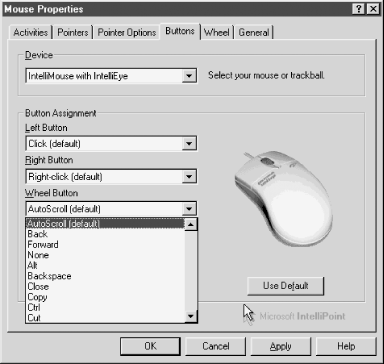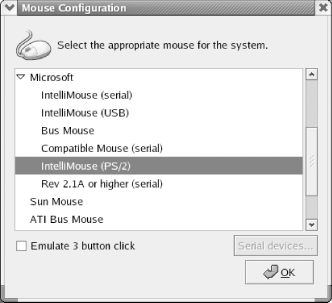20.4 Configuring a Mouse or Trackball
Windows
9X/2000/XP allows you to customize how your mouse behaves. To do so,
run the Mouse applet (Start 


- Buttons (Windows 9X/2000/XP)
-
The Buttons page in Windows 9X allows you to configure the mouse for right- or lefthanded use and specify the maximum duration between clicks that will still be recognized as a double-click. The Windows 2000/XP Buttons page has the same functions, and also allows you to specify whether a single click or a double click opens a file or folder. Changes in this dialog take effect immediately when you click Apply or OK. IntelliMouse 3.1 and later and recent Logitech mouse drivers allow or require you to specify the function of individual buttons, but don't allow you to switch between left- and right-handed configurations by clicking one option button.
- Pointers (Windows 9X/2000/XP)
-
The Pointers page in Windows 9X allows you to change the appearance of the mouse cursor. If predefined mouse scheme(s) are installed, selecting one from the Schemes drop-down list defines all cursor types in one step. Double-clicking an individual pointer type displays a list of available cursor icons that can be assigned to that pointer type. Windows 2000/XP provides the same options, and adds a checkbox to enable pointer shadow.
- Motion (Windows 9X/2000/XP)
-
The Motion page in Windows 9X allows you to set the speed of the mouse pointer using the Pointer speed slider. Depending on the mouse driver installed, other options may also appear on this page, including Snap-to (automatically move the pointer to the default option button in dialogs); Pointer trails (display a series of ghost pointers as the mouse is moved to prevent losing track of the pointer); and Vanish (hide the mouse pointer while typing). Windows 2000/XP provides the same options and adds standard Snap to default and Acceleration settings.
- Hardware (Windows 2000/XP only)
-
These pages display the type of mouse installed. The Windows 2000/XP Hardware page provides a Troubleshoot button, which invokes the Mouse Troubleshooter Wizard, and a Properties button, which simply displays Device Manager properties for the mouse.
Installing a new mouse or an updated mouse driver may add pages and options to the standard Mouse Properties dialog. For example, Figure 20-1 shows one of the additional pages that result from installing the Microsoft IntelliPoint driver supplied with the Microsoft IntelliMouse with IntelliEye (where do they come up with these names?). If you install a new mouse driver, locate and explore the options it provides. The default settings for such things as wheel definition are probably useful, but one of the alternative options may better suit your work habits.
Figure 20-1. The Windows 2000 Mouse Properties dialog as modified by installing the Microsoft IntelliPoint mouse driver

Recent Linux releases generally recognize and configure mice properly during installation, including support for extra features such as a scroll wheel or additional buttons. If you install a new mouse, run the mouse configuration utility supplied with your distro. Figure 20-2, for example, shows the Red Hat 8.X Mouse Configuration utility, which can be invoked by becoming root and running redhat-config-mouse from the command line or by clicking System Settings and then Mouse from the start menu. Because most Linux GUIs are optimized for a three-button mouse, Linux allows you to emulate a third button on a two-button mouse by depressing both buttons simultaneously.
Figure 20-2. The Red Hat 8.X Mouse Configuration dialog

The Gnome and KDE desktop environments also include utilities that allow you to change the configuration of the existing mouse. For example, Figure 20-3 shows the Red Hat 8.X Gnome Mouse Preferences dialog, which can be accessed by running gnome-mouse-properties from the command line or by clicking Preferences and then Mouse from the Start menu.
Figure 20-3. The Gnome Mouse Preferences dialog







